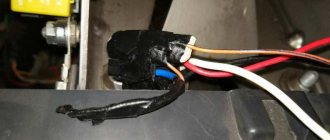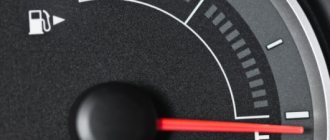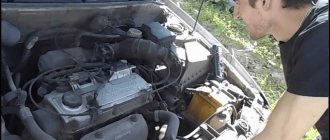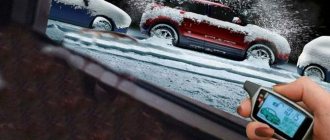Shaking and vibration in a car is dangerous. If you encounter this on the road, it's best to stop and investigate the possible problem. Today we will tell you about all the reasons that can cause your car to vibrate or shake on the road.
Of course, it will be easier to find the cause if you understand the nature of the shaking. If the car shakes in a certain gear, then you should check the transmission. If it starts to shake at a certain rpm level, have the engine checked. But often the problem is different.
We will provide you with a checklist of sorts so that you can easily find the problem and understand whether it is safe to continue driving.
Type of shaking and vibration
To better understand what's going on with your car, you need to check the type of vibration. If your car shakes while driving, there may be a problem with the suspension or wheels. If it vibrates when you start the engine, you need to check the engine - for example, one of the cylinders may not be firing. If your car shakes when braking, it's obvious that you need to check your brake rotors and pads.
Let's start our checklist by going into more detail about what can actually cause your car to vibrate under different conditions.
Other reasons that do not require repair
Even if the vibration of the car when accelerating is very strong, you should not immediately go to the service station and pay a lot of money for car repairs. After all, discomfort when driving can be caused not only by wear or bending of individual suspension components, as well as poor wheel balancing. Very often the cause of the problem is dirt stuck to the rim, ice - the problem manifests itself after off-road driving in the cold season - incorrect installation of the disks and their inconsistency with the mounting dimensions.
In the end, imbalance can occur due to a simple loosening of the discs. Therefore, you just need to monitor your car and identify simple, non-investment causes in time.
Source
Tire problems
The first reason for shaking in the car is possible problems with the tires. They may have too low or too high pressure. This will cause discomfort when driving on a bad road. A flat tire will cause severe vibration and loss of control. But even if the tire is not flat, but simply underinflated, it can cause vibration, especially at speeds above 60-70 km/h.
Uneven tire wear and defects can also be a problem. You won't feel any problems at low speeds, but once your car reaches a speed of more than 90 km/h, the tires will show their problems. Driving fast is not safe if the tires have defects. Of course, you shouldn't drive with flat tires.
If your tires are bald, you may also experience ride problems. Firstly, it is forbidden to drive on bald tires. Secondly, it is very dangerous. So it’s better to check your tires before the season and buy new ones if the old tires no longer meet the standards.
If the vibration comes from the tires, it is usually felt when you are driving above 60-70 km/h and gets worse as you accelerate. Usually things aren't that bad, but you still feel uncomfortable.
Is it possible to drive with body vibration?
For some motorists, stable vibration in a car is so natural that they get used to it and eventually stop noticing it. But if a similar effect occurs suddenly in a car, you need to immediately look for its cause. Otherwise, the driver risks getting into an accident due to damage to the suspension, chassis or transmission.
You cannot continue driving at high speed, even with the slightest vibration. In addition to discomfort, this effect can provoke other breakdowns of adjacent components and mechanisms of the car. Ignoring minor problems can result in more expensive repairs.
In most cases, vibration elimination can be performed at any service station, and it is not an expensive procedure. It will be much more expensive to eliminate the consequences of damage caused by high-frequency beats.
Wheels
A poorly balanced wheel is one of the most common problems that cause vehicle vibration. You shouldn't have any problems driving around town at low speeds. But once you reach 90 km/h or more, poorly balanced wheels will remind you that they need to be repaired. The car begins to shake intensely after 100-110 km/h, and drivers usually decide to drive slowly so as not to feel the strong vibration.
But be very careful. A poorly balanced wheel can cause problems with the suspension and even the wheel threads. If you notice that your car is shaking at high speeds, it is better to reduce your speed to 60 km/h and change route to the nearest service center.
Also damaged wheels will show exactly the same problems. If the wheel is bent, broken, or changed shape, it is unsafe to drive. It's best to use a spare tire.
Balancing required
Runout on the steering wheel and car body with increasing speed is inevitable if the wheels are not balanced. The uneven distribution of mass relative to the center of the wheel rim leads to such consequences. The action of multidirectional centrifugal forces leads to the appearance of multi-frequency oscillations, which are felt as a beating in the car interior.
The problem may manifest itself in the following cases:
- Installing new tires. Replacing tires on rims or putting new rims on old tires must be accompanied by balancing. Even for the manufacturer, achieving ideal weight distribution and geometric parameters seems to be an extremely difficult task.
- Loss of old balancing weights. This is especially true for light alloy wheels, where the weights are glued to the inside of the wheel. Let us remember that in the case of stamped rims, the weights are placed in the outer shoulder of the rim.
- Deformation of the rubber or disk due to falling into a deep pothole, a strong impact with the curb and other similar obstacles.
- Natural imbalance. During operation, any wheel will lose its established balance. It is recommended to carry out scheduled balancing every 15-20 thousand km.
Another breeding ground for imbalance is often the constant velocity joint. It serves as a device for the movable articulation of the drive shaft and gearbox, which allows the transmission of torque in different planes (internal CV joint). At the other end of the drive shaft for articulation with the hub (outer CV joint).
Most often, the cause of vibrations lies precisely in the internal hinge. In the case of a tripod-type design, wear out of the rollers is observed. In especially severe cases, the bearing may even “fall apart”. It is also possible to produce a tripod glass.
A similar malfunction can be caused by a torn boot, which can no longer protect against dirt and dust flying from under the wheels. Therefore, periodically check the integrity of the CV joint boots.
Drive shaft
It will be worth mentioning that a car with a drive of irregular geometric shape is guaranteed to experience vibration when accelerating. A bent drive shaft will not only rotate around its axis, but also provoke parasitic centrifugal forces. As a result, the car will receive additional vibrations as it accelerates.
Cardan
The problem is typical for cars with rear-wheel drive and all-wheel drive. Wear of the cardan joint leads to vibration during acceleration. If you encounter a similar problem, pay attention to the following elements:
- crosses;
- suspension bearing;
- directly to the driveshaft. An unbalanced cardan will lead not only to beating, but also to subsequent destruction of the joints.
There were cases when the cause of runout at speed was play in the gearbox shank. This also needs to be paid attention to.
Wheel bolts
If your car starts to shake at low speeds and the vibration becomes unbearable when driving at 60 km/h, it means there is a problem with the wheel bolts or nuts. Stop driving immediately because one of the wheels may simply fall off if you continue driving. Park the vehicle carefully and check the nuts or bolts.
Driving with loose wheel bolts is very dangerous for your health and for the car. Suspension parts can break quickly and the wheel mounting system can fail, so you'll have to spend quite a bit of time and money on repairs. After visiting the service station, it is recommended to check whether the service workers have tightened the bolts well enough.
Reasons depending on speed
Experts have introduced a gradation of breakdowns that manifest themselves depending on the speed limit chosen by the driver. The easiest way to find the reasons for car vibration is when driving at speeds up to 40 km/h. If, while turning, the driver hears an unpleasant crunch that penetrates the interior, then most likely this is a faulty CV joint.
However, approximately the same sounds can be produced by such a part of the steering as the rack. And if shaking starts when the gear is changed, this is a clear sign of a gearbox malfunction. In a manual transmission, it can also be caused by wear on the release bearing and friction mechanism. Further, with increasing speed, experts note the following problems.
40-60 km/h
There may already be problems with the cardan mechanism, primarily with the outboard bearing and crosspiece. At the same speed, the vibration can be caused by the exhaust system - its integrity is broken or the fastening is unreliable. And if vibrations are transmitted not only to the body, but also to the steering wheel, then they most likely indicate wheel imbalance.
60-80 km/h
Vibration of the car when driving in this speed range may indicate that there are problems with the braking system. This is indicated by a characteristic sound. Imbalance of the rotating elements of the motor - flywheel, pulleys, fan, etc. - can also lead to an unpleasant effect. The list of potential problems also includes tires whose tread wears out at different rates on different wheels. Finally, simple clogging of the fuel filter, as well as a lack of transmission oil in the automatic transmission, also cause hesitation.
80-100 km/h
Suspension parts begin to contribute to vibration processes when driving at such speeds. Moreover, for the problem to appear, only minor wear, including ball joints, is enough.
It should be noted that this list shows the most likely causes of car vibration when driving. However, there are others. For example, a difference in tire pressure, a slightly bent disk, etc. In addition, the relatively low speed of movement allows the driver to brake or pull to the side of the road in time in the event of an emergency.
And it’s a completely different matter – driving at a cruising speed of 100-120 km, which is practiced by many drivers on country roads. There are many more potential reasons for hesitation here, and they occur more frequently. Therefore, many professionals classify this speed limit as a separate category.
Worn supports and CV joints
Failed ball joints will cause shaking and vibration at higher speeds. The CV joints will make a knocking noise when turning sharply. If these parts are broken, it is better to stop driving the car. You can drive carefully to the service station if the station is not that far away, but drive slowly.
Axle shaft joints cause severe vibration when they are completely worn out. If they fall apart, you will not be able to drive the car, since torque will not be transmitted to the wheels. If you hear a particular noise when turning, be prepared to replace your CV joints before they start causing you problems.
Engine vibration at idle - what can be adjusted?
In order to adjust the idle speed, you need to use some components and assemblies installed in the car. In the first case, it is a carburetor or injector that is part of the fuel system, producing a mixture of fuel and air. In addition, you need to adjust the fuel pump, check all sensors, fuel pressure regulator and other engine elements.
We recommend: Car diagnostics via laptop
You need to know that the number of revolutions depends on the degree of opening of the throttle valve, which regulates the air supply, as well as on the operation of the idle air valve, which supplies air independently of the throttle. You can increase the idle speed using the accelerator pedal.
Any vibrations, no matter what they occur from, have a very bad effect on the operation of the car. Vibrations cause discomfort to both the driver and passengers, and also have a bad effect on the car. Over time, cracks may be noticed on the body, and bolts and nuts may loosen. These shortcomings can lead to any consequences and cause an emergency.
Broken suspension parts
If one of the shock absorbers is broken, it can cause shaking. It can also create different types of noise that will indicate to you that there is a problem with your suspension. Vibration can also start if there are problems with the suspension arms or any mounting.
Another possibility is that the suspension mounting points are broken. This can happen to older cars that have a lot of rust on the body. The installation site may rust, so the bolts will not hold up. This will result in you spending a lot of money on body repairs. Vibrations and sounds can be the result of problems with both the front and rear suspension.
Rubber
There are often cases when vibration when accelerating appears due to the installation of low-quality tires. Most often these are tires from budget and extra-budget manufacturers. The peculiarity of such rubber is that when checking on a balancing stand, a discrepancy that causes discomfort when driving a car may not be noticed. In the second case, balancing only temporarily delays the reappearance of vibrations. Only replacing the tires will solve the problem.
The next reason for the appearance of unwanted vibrations is typical for owners whose car is shod with low-profile tires. The side cord of such tires does not have the rigidity and elasticity that is inherent in civilian versions of tires. Therefore, prolonged downtime, especially in the warm season, can cause temporary deformation of the tire at the point of contact with the road surface. Therefore, vibration during acceleration may be observed for a short time after the start of movement. The first kilometers should be covered with extreme caution.
Steering
The steering rack and linkages can also cause vibration and shaking.
If the steering rack is faulty, the steering wheel may shake. Sometimes you may also feel some vibration on the pedals because the pedals and rack are usually mounted on the same metal board.
Rods and lugs can also cause problems. When they break, you will have difficulty moving the car in the desired direction. She will constantly try to change direction and put you in a dangerous situation. Additionally, broken steering parts can cause severe vibration that you will feel in your steering wheel. A certain knocking noise may also be heard. It is dangerous to continue to drive a car if the steering system of the car is faulty.
Unreliable wheel mounts
This problem is also easy to fix and diagnose. This is a simple but very dangerous reason. The fastenings can be loosened even on one wheel, and this is enough to cause shaking. If the problem is not resolved in time, emergency situations may occur. If the wheel falls off while driving, the repair will be quite expensive - you will have to replace the disc and hub, and the brake disc.
The symptoms in this case are very similar to vibrations due to tires or bent wheels. But there is a cyclical pattern here, although not at all speeds.
Wheel alignment
Surprisingly, many car owners are not aware that their cars require special maintenance, which is often missed during regular servicing. Toe and camber should be adjusted at least once a year. It is better to check the wheel angles every six months to ensure that your tires last longer.
Typically, vehicles with misaligned tires exhibit poor handling. Vibration and shaking occur when accelerating to speeds over 100 km/h. With slight changes in angles, the shaking may be barely noticeable.
How to eliminate car vibrations. And why are they dangerous for the car?
Are you familiar with the situation when your car begins to vibrate noticeably after installing new rims? Or when the same problem occurs when installing used tires? Avto.pro explained the dangers of body vibrations and how you can eliminate them yourself.
Why are vibrations dangerous?
The driver may get used to body vibrations and think that this is normal. What if the shaking becomes strong, objects on the dashboard begin to move from side to side, and the picture in the rearview mirror begins to twitch? This is serious
cause for concern. Next, we will try to classify body vibrations and highlight the main reasons for their occurrence, and also outline options for solving problems.
What are the vibrations?
Perceptible vehicle vibrations usually occur when driving at high speed. However, in some cases, drivers encounter a problem even at idle speed right after starting the engine or when increasing the speed before moving off. Let's look at these points in more detail.
Tire wear
It is important for a car enthusiast to be able to read the tread pattern and sidewall. As a rule, tires should be checked before each trip and cleaned of dirt. The vibrations will become stronger and more noticeable the higher the speed of the car. They usually become noticeable at speeds above 50 km/h. The steering wheel will begin to vibrate first.
Problem wheels
If you suspect deformed rims or even problematic tires, get out on the highway and accelerate to 100-120 km/h. If the wheels are unbalanced due to their deformation, vibrations will become clearly noticeable. Inspect both the rims and tires. In case of purchasing used. components, such checks must be especially careful. It is not worth operating a car with problem wheels and tires.
Engine malfunction
A normally running engine will vibrate in any case, but if this affects ride comfort, then the driver should first check the supports and, if necessary, replace the main consumables. Separately, it is worth causing vibrations in an unbalanced engine. The problem here is more serious. The driver will have to contact specialists. You will need to align the shafts, replace the pistons, etc. – expensive diagnostics and repairs.
Problematic brakes
In rare cases, vibrations are caused by a stuck caliper. The caliper itself can be serviced - there are special repair kits and lubricants for this. Pads can be called one of the automotive consumables. They need to be changed when worn. Some pads are hard and over time they “eat away” the brake disc. This is evidenced by the appearance of concentric grooves. The disc may become deformed due to strong temperature changes
and/or become rusty. The worse its condition, the higher the likelihood of vibrations during braking.
Discs with a thin layer of rust, dirt and brake pad marks can be cleaned with a brush. Don't let the latter scare you too much - under extreme heat, some of the friction material of the pad may be imprinted on the surface of the brake disc. However, this also indicates that you installed pads on your car more for a quiet ride than for a sporty one.
Malfunction of electrical appliances
General recommendations
As can be understood from all of the above, vibrations of the car body can occur in a variety of cases. Sometimes they do not even indicate a breakdown of any component - you just need to carry out balancing
and calmly continue driving. Many car enthusiasts eliminate vibrations on their own. Should you contact a car service if you are worried that you will not be able to make repairs yourself? We propose the following algorithm of actions:
Conclusion
Drivers should not ignore the problem of vibrations of the entire body or individual elements of the car. They lead to rapid wear of entire components, which over time will result in expensive repairs. Add to this the reduction in safety and driving comfort, as well as the negative impact on the physical and mental health of the driver and his passengers.
Often the problem is solved by replacing the tires and reinstalling the rims using spacers. Otherwise they are called instep supports and centering rings. But if the vibrations are associated with malfunctions of suspension parts, cardan or engine mounts, then the driver will have to buy spare parts and install them himself or contact specialists. All this is worth the money spent.
If you find an error, please select a piece of text and press Ctrl+Enter .
Source
Engine
The engine may shake on several occasions.
The most common problem occurs when engine mounts and support pads break. You can check this by rocking the engine yourself. If the engine shakes too much, the mounts are worn out. If the engine is shaking and colliding with other parts under the hood of your car, the mounting system needs a complete overhaul.
Problems can also arise when one of the cylinders does not work. This may be the result of troubles such as a burnt piston or a crack in the cylinder block. But usually it's all about the spark plugs or wires.
The electrical system can also cause problems with engine performance. If one of the cylinders is not firing, the engine will shake all the time and it will also lose power.
Why does the car jerk while driving? Reasons for car jerking while driving
Malfunctions and disturbances in engine operation can manifest themselves in different ways, starting with suspicious sounds coming from under the hood, leaks that remain on the asphalt after a long stay, ending with jerks while driving.
Jerking while the car is moving can occur no matter how much you press the gas pedal; this occurs as a result of a short-term change in the speed of rotation of the crankshaft.
Dips can occur not only during acceleration, but also when releasing the gas, as well as with constant movement and the same position of the gas pedal. In order to understand why the car jerks when driving, it is best and easiest to contact specialists at a service station, because...
Most likely, you will have to carry out a complete diagnosis of the fuel system and injection system, and for this, as you understand, you need to have special equipment.
In most cases, jerking while driving occurs due to a lack of pressure in the fuel rail, or as a result of a malfunction of the throttle position sensor (TPS).
The car jerks while driving - reasons
Sometimes when you start moving, when you start moving, a “failure” occurs, and often for beginners this can even cause the engine to stall.
This effect occurs precisely at the moment when the throttle valve opens, when the engine goes from idle to load mode.
In modern engines, the motor helps the driver, for smoothness the ECU, having received a signal from the TPS about the throttle position, will increase the fuel supply. However, if the pressure in the fuel rail is weak, there will still not be enough fuel.
The reason for jerking while driving may also lie in the electromechanical part of the throttle valve or in its banal contamination by crankcase gases. The cause of such contamination can also often be caused by insufficient pressure in the fuel rail.
When you sharply press the gas pedal in order to instantly accelerate, the throttle valve opens very wide, while the ECU, having received a signal from the TPS about the throttle position, without having the required pressure, is simply not able to provide the engine with the required amount of fuel.
In cars with automatic transmission, the car jerks when accelerating due to a faulty gearbox or, for example, because the oil level in it is too low. Sometimes “jokes” with the gearbox can occur after disconnecting the battery immediately before a trip; this phenomenon is “not fatal” and, as practice shows, goes away by itself after several accelerations.
Often the reasons are completely banal, for example: the fine fuel filter is clogged, the fuel pump mesh is clogged, etc. But I think that you, like most of us, checked this first, and if not, then by all means do it.
The car jerks while driving - reasons
As a rule, such jerks occur due to a malfunction of the ignition system. However, if a problem occurs on the road, you can try to fix the problem yourself. To do this we do the following:
- Turn off the ignition, lift the hood and make sure that all high-voltage wires are securely attached to the coil and spark plugs.
- Then start the engine and listen to the engine, listen for any extraneous crackling or clicking noises. The point is to check whether there are any “breakdowns to ground”, that is, whether the spark is going somewhere else other than the spark plug. This is best checked in the dark, then you will not only hear a crash, but also see how it hits, for example, on the body or somewhere else.
If the check does not lead to anything, I recommend unscrewing the spark plugs and inspecting them; perhaps there is carbon on the spark plugs or they simply need to be replaced.
If you have a set of new spark plugs, check to see if the engine's performance changes or if the jerking goes away after replacing the spark plugs.
If the car jerks at speed even after replacing the spark plugs have disappeared, then the problem was in them, but if not, continue searching or try to reach the nearest service center, they will certainly help you solve your problem.
ford-master.ru
Transmission
Again, the transmission mount and support pads should be checked first. Then check the fasteners. If the car shakes during acceleration, or the car accelerates jerkily, check the transmission itself. In robotic transmissions such as Ford Powershift or Volkswagen DSG, the clutch system may be broken. In a traditional automatic transmission, shaking can be a sign that the transmission is about to die. But sometimes an oil change can extend the life of your transmission and help you deal with the problem of shaking and jerking.
Brake pads and discs
If your car begins to shake or vibrate when braking, the most likely cause is the brake rotor. It may be damaged, worn or bent. Additionally, if the brake pads are worn out, they can cause shaking. In many cars this is easy to check. Just place your finger on the surface of the brake disc and check for damage or scratches. If the disc has a deep groove in the working surface, you may need to replace it.
If your vehicle's brakes cause shaking or vibration, do not drive. It is very dangerous. The brake system requires special inspections every time you service your vehicle.
Wheels do not comply with factory recommendations
A car rim has its own parameters - width, tire mounting diameter, offset, as well as the diameter of the drill, i.e. the circle on which holes are drilled for mounting bolts or studs. For each wheel model, the number of these holes and their diameter are indicated. If the disk parameters are incorrectly selected, the mount will not screw in completely and will not press the wheel tightly to the hub. As a result, the disk has play. If the diameter of the holes drilled does not match, the wheel will also not sit in its place. Of course, it can be planted using physical force. However, the plane of the disk will not coincide with the parameters of the hub. This is not good for the car.
Half shafts
Most cars have two axle shafts that connect the transmission to the wheels. If one of the axles is bent, it can cause major problems and damage. Usually the car starts to shake when you accelerate to a speed of more than 100 km/h. But it all depends on how badly the axle is bent. A damaged axle shaft can easily damage the transmission or create additional suspension problems. If the vibration is strong and you feel it even at low speed, it is better to stop driving. The repairs will not be too expensive or time-consuming, but in this case it is not safe to drive further.
Shaking starts at idle
It happens that the car begins to shake when accelerating, or vibration occurs when waiting for a traffic light. That is, the problem is observed precisely at idle speed.
There are 2 main reasons, the likelihood of which is the greatest. We will consider them.
- Problems with the engine when burning the air-fuel mixture. The body shakes if the fuel burns unevenly. In this case, the speed can drop and rise sharply, and this phenomenon is beyond the control of the driver. There are many reasons for incorrect combustion of fuel, ranging from failed sensors to a breakdown of the fuel pump. You need to take diagnostic equipment and check the car with it when it starts to shake;
- The supports are no longer able to support the motor. Over time, supports can become loose, bend, or simply break. In such a situation, vibrations will already affect the body directly. This is immediately felt in the form of shaking at idle.
It is important to add that similar phenomena characteristic of shaking at idle can also occur when driving. It doesn't really depend on whether everything happens in summer or winter.
Fuel
Sometimes problems can be caused by the quality of the fuel. For example, if you fill up with diesel instead of gasoline at a gas station, the engine will begin to shake and vibrate, and then may simply stall. If you use low-quality fuel, the fuel filter will immediately become dirty, and it will be quite difficult for the fuel pump to provide the necessary pressure in the system. This can cause low fuel pressure in the fuel injectors, which can cause shaking and vibration.
When overclocking
If body shaking is observed only during acceleration and stops when the speed reaches 80–90 km, the problem should be sought in the operation of the internal combustion engine and fuel system. The cleanliness of the fuel filters and the correct operation of the injectors are checked. Some other causes of the problem:
In 30% of cases, the cause of major repairs is ignoring body vibrations associated with wear of the universal joint.











